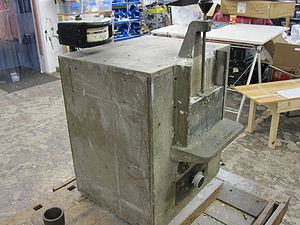Equipment/Kiln
Thanks to efforts of various members, we have a kiln!
Make
It is apparently a Gallenkamp Muffle Furnace exact type: unknown.
Please be careful hacking this as there may be asbestos inside of it. The asbestos should be internal (i.e. only a risk if you open up the back etc) but please be careful and wear a mask (asbestos safe) until confirmed one way or another.
Status
The kiln has been used several times now. The door is a bit broken, it will still insulate enough to get hot, but it is hard to open and close. I attempted to cement it back together with fire cement, but the bricks really need to be taken off and replaced with new ones. Getting them off seems difficult! - Luke
Instructions
Plug it in, jam a stick in the back to hold the valve open, put stuff inside.
Log
The kiln is working, though the thermostat is not calibrated, so when you're using it, you may need to set the temperature yourself.
From Abby:
- New PID controller has been installed in the kiln - the control switches cleaned back to their original steampunky brass, metal panel repsrayed by sol and purple stars stencilled by Jasper! Oh, and thanks Phil Ceph for the 13amp wire :)
- The new controller is quite cute, simply press up and down to select temperature in degrees C. A max temperature has also been programmed in so noobs dont set the kiln to the temperature of the core of the sun and walk away (gonna be pricey on the electrics!)
- We're still calibrating it - the probe is comes with is supposedly a max 800c affair, but I aspire to melt silver, so we've not fire cemented it in place yet. Also, temperature sensing may be incorrect. I was seeing glowing red walls and reading a temperature of 367. Hmm.
- So we're still calibrating it. I've left the PID manual on top of the kiln. You can play with it and try to verify if our temperature setup is correct, but please dont change passwords or muck with PID settings without checking. There exist cute little kiln calibrating cones which melt at specific temperatures, so we may use these to get an accurate lock.
